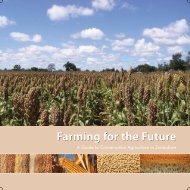Restoring the Soil - Canadian Foodgrains Bank
Restoring the Soil - Canadian Foodgrains Bank
Restoring the Soil - Canadian Foodgrains Bank
Create successful ePaper yourself
Turn your PDF publications into a flip-book with our unique Google optimized e-Paper software.
Decision Tree Guide53each metre in hedgerows 8 to 12 m apart. <strong>Soil</strong> improvement using nyama willbe a slower process than with jackbeans, because <strong>the</strong> nyama grows much moreslowly. However, this technology could be used in areas where it is so dry that <strong>the</strong>animals are eating <strong>the</strong> jackbean. There is also a tremendous advantage in having apermanent gm/cc, ra<strong>the</strong>r than one that has to be planted every few years, like <strong>the</strong>jackbean. When nyama is planted in maize, sorghum or millet fields, it does notneed to be pruned at all during <strong>the</strong> wet season, which is a major advantage overalley cropping systems.For examples of o<strong>the</strong>r hedgerow technologies, consider S21, S25, S58 or S82,and <strong>the</strong>n go to #5. Recently, mo<strong>the</strong>r of cacao hedgerows have been gainingpopularity in Haiti, Indonesia and <strong>the</strong> Philippines. However, <strong>the</strong>y had not beenused long enough when I saw <strong>the</strong>m to justify being included in <strong>the</strong> list of successfulgm/ccs below.46. Gm/ccs for rice. The search for gm/cc systems that work well with rice, whe<strong>the</strong>rupland rice or paddy rice, has been a frustrating endeavor. Rice is such a shortstaturecrop that it is difficult to find anything that can be intercropped with it.Besides, very few legumes can survive for long in standing water. Luckily, <strong>the</strong>reis not too much pressure to find gm/ccs for rice. For one thing, <strong>the</strong> System ofRice Intensification (SRI) is raising rice yields dramatically around <strong>the</strong> worldwithout gm/ccs, and many rice farmers are busy learning about and refining <strong>the</strong>iruse of SRI. [For information about SRI, see http://sri.ciifad.cornell.edu/index.html]. Secondly, rice has such a good international price that farmers can easilyuse chemical fertilizer, ga<strong>the</strong>r organic matter from o<strong>the</strong>r fields or apply compostwithout losing money. Both <strong>the</strong>se factors reduce <strong>the</strong> urgency of finding gm/ccsfor rice. Even so, <strong>the</strong>re are a limited number of options for using gm/ccs withrice.If <strong>the</strong> dominant system is upland rice, go to #47. If it is paddy rice, go to #48.47. Upland rice. In nor<strong>the</strong>rn Laos, pigeon peas and a crawling variety of cowpea (alsofound in certain areas of Africa, including parts of <strong>the</strong> Sahel) are intercropped insome upland rice fields. Choose S72 or S73, <strong>the</strong>n go to #5.48. Paddy rice. If development workers and <strong>the</strong> farmers are interested in using atraditional green manure system, see S76 and <strong>the</strong>n #5. If a system with a rotatedor relayed gm/cc sounds more interesting, see S74, S78, S79 and S80. Afterwards,go to #5. If people are interested in using azolla, an algae that grows inpaddy water and fixes nitrogen, go to S81.49. Many of <strong>the</strong> fields are not intercropped. By and large, maize fields that have noo<strong>the</strong>r crops growing in <strong>the</strong>m can be intercropped with any one of a large numberof leguminous gm/ccs. In high-rainfall areas, mucuna can be intercropped withmaize. Plant it at least 30 to 40 days after <strong>the</strong> maize, and allow <strong>the</strong> mucuna togrow until <strong>the</strong> next crop of maize is planted. The mucuna may need to be pruned
















